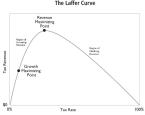Tag Archives : fiscal policy
Doubling Down on Failure: Former Obama Official Calls for U.S.-Financed Keynesian Spending Binge in Europe
There’s an old saying that insanity is doing the same thing over and over again while expecting different results. This certainly is a good description of Keynesians, who relentlessly push more government spending as some sort of magic potion for the economy – notwithstanding a record of failure. The latest example is Larry Summers, the former […]
read more...Measuring the Federal Government’s Spending Problem
I’ve complained endlessly that America’s fiscal problem is too much spending, and that deficits and debt are best understood as symptoms of that underlying disease. So I’m obviously a big fan of this new video from the folks at Learn Liberty. I like how they use several types of measurements to show that there’s plenty […]
read more...The “Penny Plan” to Trim Government Spending and Reduce the Burden of the Public Sector
Even though I favor radical reductions in the burden of government, I’ve made the point that good fiscal policy merely requires that government spending grow slower than the private sector – what I call Mitchell’s Golden Rule. And if lawmakers simply cap the growth of spending, so that it grows by about 2 percent annually, […]
read more...Portuguese Finance Minister Admits Keynesian Stimulus Was a Flop, but Don’t Hold Your Breath Waiting for Obama to Make a Similar Confession
President Obama imposed a big-spending faux stimulus program on the economy back in 2009, claiming that the government needed to squander about $800 billion to keep the unemployment rate from rising above 8 percent. How did that work out? One possible description is that the so-called stimulus became a festering pile of manure. About three […]
read more...Explaining in the New York Post Why Obama’s Soak-the-Rich Tax Policy Is Doomed to Failure
I think high tax rates on certain classes of citizens are immoral and discriminatory. If the government is going to collect revenue, all taxpayers should be treated equally, with something akin to a simple flat tax. But most people don’t seem to care about having the law apply the same to all people, so I […]
read more...Professor Greg Mankiw: If You Value Individual Liberty, then Protect, Promote, and Preserve Competition Between Governments
Other than my experiment dealing with corporate taxation, the first video I narrated for the Center for Freedom and Prosperity dealt with the issue of tax competition. It was a deliberate choice because I view competition among governments as one of the few effective restraints on the greed of the political class. Simply stated, in […]
read more...Time to Follow Sweden’s Lead on Fiscal Policy
Sweden has a very large and expensive welfare state, but it’s actually becoming a bit of a role model for economic reform. I’ve already commented on the country’s impressive school choice system and noted that the Swedes have partially privatized their Social Security system. I even wrote a Cato study looking at the good and […]
read more...The Right Capital Gains Tax Rate Is Zero
The silly debate about the “Buffett Rule” is really an argument about the extent to which there should be more double taxation of income that is saved and invested. Politicians conveniently forget that dividends and capital gains get hit by the corporate income tax. And since America now has the developed world’s highest corporate income […]
read more...The Laffer Curve Shows that Tax Increases Are a Very Bad Idea – even if They Generate More Tax Revenue
The Laffer Curve is a graphical representation of the relationship between tax rates, tax revenue, and taxable income. It is frequently cited by people who want to explain the common-sense notion that punitive tax rates may not generate much additional revenue if people respond in ways that result in less taxable income. Unfortunately, some people […]
read more...Notwithstanding the “Grand Bargain” Siren Song, there’s No Practical Argument for Tax Hikes
Many people think that my opposition to tax increases is ideological, but they’re wrong. If someone told me that I magically had the power to flick a switch and give the country a flat tax, but that simple and fair tax system would only be possible if the rate was set high enough to give […]
read more...



